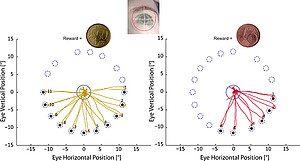The effect of subliminal reward signals on sensory perception

Human agents are influenced by subliminal cues, that are presented below the threshold for conscious awareness, in a large number of situations. A notorious example of subliminal effects is seen in how we are swayed to like products that are subliminally advertised (the infamous example of Coca Cola advertisements is a clear case). Neuroscience research has shown that even seemingly voluntary, and effortful actions are influenced by subliminal cues since people are willing to exert more effort in expectation of receiving higher monetary rewards even when the reward cues are displayed subliminally. So far, the effect of subliminal cues on decisions that involve eye movements has not been explored. Eye movements are fast, somewhat effortless and frequent (100 per second) types of motor actions. We designed a task that required fast, sequential eye movements to several targets, thus enhancing the effort that is required from human participants to fulfill the task. The number of targets that were hit by participants determined the amount of money that the received in each trial. Importantly, the amount of money at stake varied across trials resulting in some trials being associated with either high or low monetary reward. Reward cues (pictures of Euro coins) were displayed either supra- or subliminally. Similar to previous studies, we showed that human eye movement speed reflects the degree of conscious awareness of reward cues: when lower reward was at stake eyes moved slower and this effect was stronger for consciously perceived rewards. However, unlike other motor actions, eye movements seemed to require higher level of conscious awareness of reward to be up- or down-regulated by reward expectation. This difference might be due to the fact that eye movements require lower net amount of effort compared to other types of movements and are only slowed down when the prospect of reward is consciously perceived to be very low. Alternatively, this difference could be due to the type of the task that we employed and therefore our results await generalization across different task types. If proved to be a general feature across tasks, our results might demonstrate an interesting exception to the rule that humans are invariably affected by subliminal cues. This finding may thus indicate that not all our actions are subject to be controlled by unconscious external factors.
